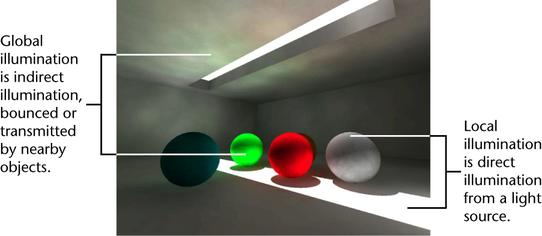
Indirect (Global illumination)
Indirect light is all the inter-reflected light in a scene. Global illumination is an approximation of real-world indirect light transmission.
With global illumination, the contribution of bounced light from other surfaces in the scene is used to calculate the overall light contribution and the color values at points on objects that are not directly illuminated (that is, at points that do not receive light directly from a light source, such as a spot light).
Global illumination occurs when light is reflected off of or transmitted through an opaque (reflection only), transparent or semi-transparent surface (refraction) to bounce off or be absorbed by another surface.
Examples:
- A crack at the bottom of a door can cause light to spill into a room.
- White walls reflect light from the light source to another surface in a room.
- A body of water can transmit light from its surface to the floor. (This is an example of Caustics, a form of global illumination.)
Local illumination (Light sources)
Local illumination is only the light provided directly from a light source (such as a spot light).
Direct light is emitted from a light source and travels in a straight path to the illuminated point (either on a surface or in a volume).
With direct illumination only, each light source's contribution is used to calculate the overall light contribution to any given illuminated point.
Examples:
- A spot light illuminates an actor on stage
- Sunlight shines directly on sunbathers
